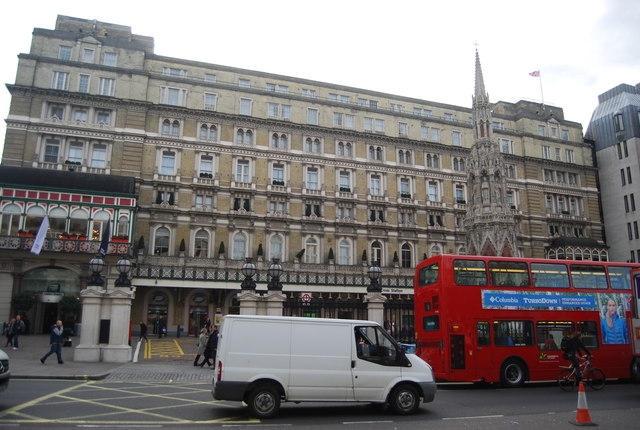TQ3080 : Charing Cross Station
taken 9 years ago, near to London, The City of London, England

The London terminal for trains from Kent and Sussex.
The original station was opened by South Eastern Railway on 11 January 1864 and designed by Sir John Hawkshaw. A year later the Charing Cross Hotel, designed by Edward Middleton Barry, opened on 15 May 1865.
In December 1905 part of the roof collapsed and had to be entirely replaced, the station reopened in March 1906.
In 1990 most of the area over the platforms was covered by Embankment Place, a post-modern office and shopping complex designed by Terry Farrell and Partners. This development led to the replacement of the 1906 roof.
Charing Cross denotes the junction of the Strand, Whitehall and Cockspur Street, just south of Trafalgar Square in central London. It gives its name to several local landmarks, including Charing Cross railway station, one of the main London rail stations.
Charing Cross is named after the now demolished Eleanor Cross that stood there. A Victorian replacement, in different style from the original, was later erected a short distance to the east outside the railway station. Grade II* listed. Link
Listed buildings and structures are officially designated as being of special architectural, historical or cultural significance. There are over half a million listed structures in the United Kingdom, covered by around 375,000 listings.
Listed status is more commonly associated with buildings or groups of buildings, however it can cover many other structures, including bridges, headstones, steps, ponds, monuments, walls, phone boxes, wrecks, parks, and heritage sites, and in more recent times a road crossing (Abbey Road) and graffiti art (Banksy 'Spy-booth') have been included.
In England and Wales there are three main listing designations;
Grade I (2.5%) - exceptional interest, sometimes considered to be internationally important.
Grade II* (5.5%) - particularly important buildings of more than special interest.
Grade II (92%) - nationally important and of special interest.
There are also locally listed structures (at the discretion of local authorities) using A, B and C designations.
In Scotland three classifications are also used but the criteria are different. There are around 47,500 Listed buildings.
Category A (8%)- generally equivalent to Grade I and II* in England and Wales
Category B (51%)- this appears generally to cover the ground of Grade II, recognising national importance.
Category C (41%)- buildings of local importance, probably with some overlap with English Grade II.
In Northern Ireland the criteria are similar to Scotland, but the classifications are:
Grade A (2.3%)
Grade B+ (4.7%)
Grade B (93%)
Read more at Wikipedia Link
